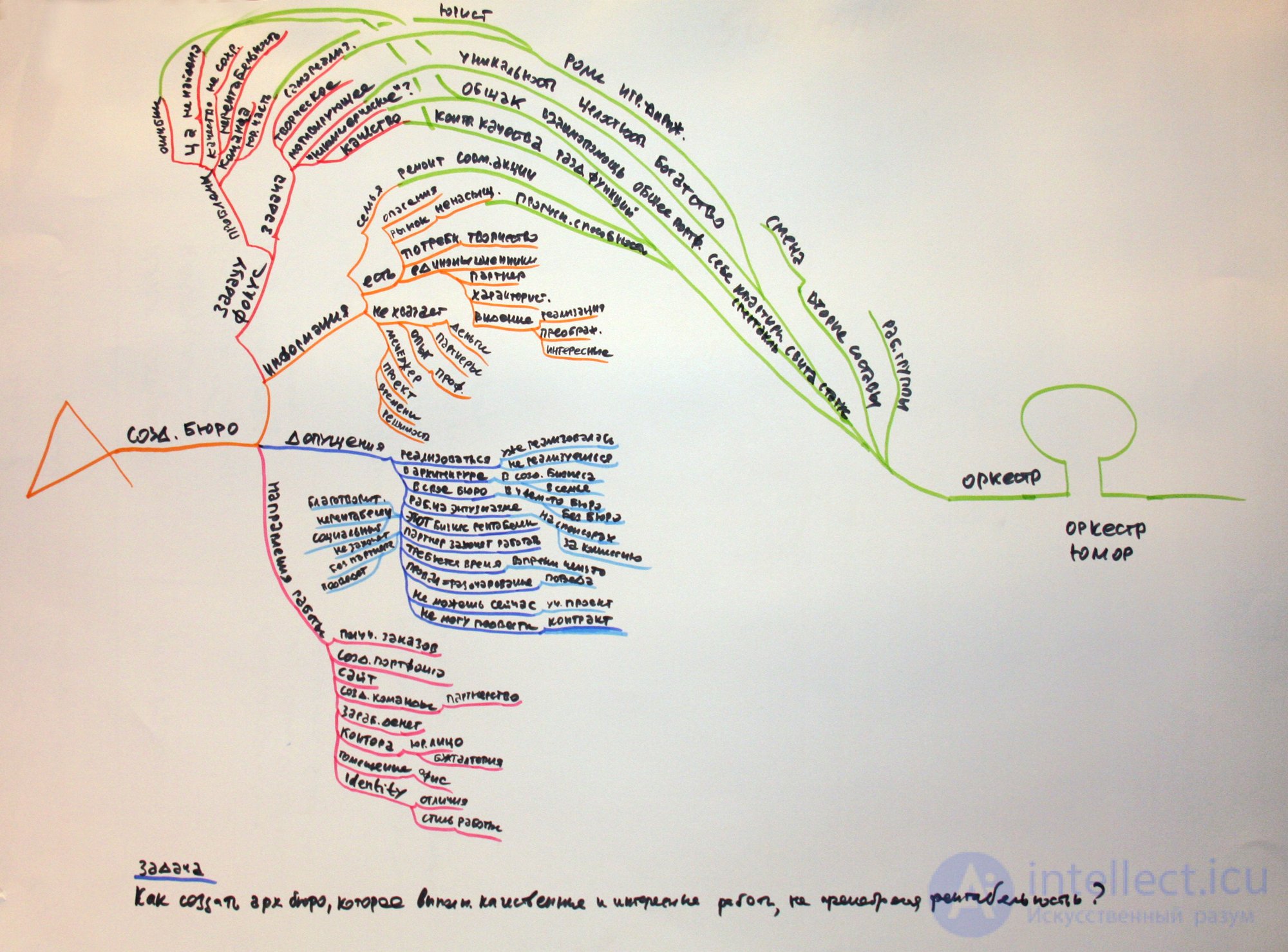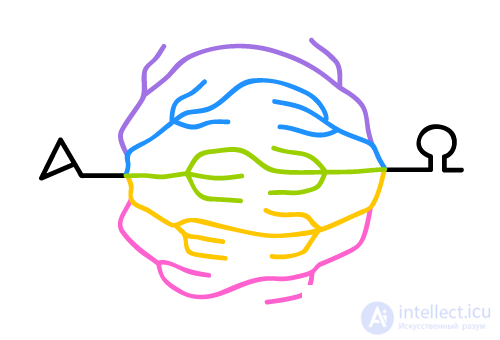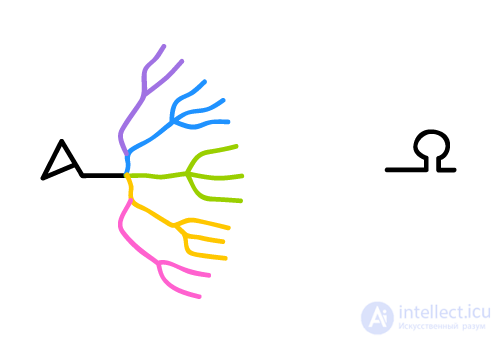
Omega mapping is an idea creation method that helps you find holistic solutions to complex problems. Omega mapping uses a special technique to visualize the process of finding a solution, making it visual and structured.
Applications
- Finding solutions
- Professional idea creation
- Creating new products, projects and services
The essence of the method
Finding solutions using omega mapping consists of two stages:
- Fixing the initial ideas about the problem and the search for its possible solutions.
- The choice of the main idea and the restructuring of the original ideas.
To visualize this work, an omega card is used. Unlike an ordinary mental map, it has not one central theme, but two poles (alpha and omega points), denoting initial and final ideas about the problem.
Schematic image of the omega card.
Use a large format sheet for the card.
Alpha and Omega points
The omega map is built between the alpha and omega points. Alpha is our starting point, the point at which we begin our work. Omega is the final concept, the point to which the solution of our problem converges. Omega is not derived from the original data in a rational way - the transition to it is accomplished through a jump, a shift in thinking, which is assisted by the use of various techniques for generating ideas. After the jump, there is a restructuring of the existing picture and the creation of a new one, as well as the construction of rational connections with the original data.
For visualization and structuring of the thinking process, the technique of mental maps is used: thoughts are recorded in the form of keywords located on interconnected lines (“branches”). The group of lines emanating from the alpha point is called the alpha tree, and the group of lines entering the omega point is called the omega tree.
Step 1. Alpha-tree: Fixing existing representations and finding solutions
Place the alpha sign on the left side of the page and the omega sign on the right side. Draw a line from alpha in the direction of omega and write on it a topic on which you will work. Then start drawing a mental map of it with the branches oriented to the right.
Alpha tree
An alpha tree can be built either arbitrarily or using a certain initial structure - a set of main branches. In this case, you can create more focused methods for working with specific types of tasks. The only required elements of the set are the “Task” and “Idea” branches. Examples of already developed structures are at the bottom of the page.
- Task . Create a “Task” branch on the alpha tree and place on it all the tasks that your concept is intended to solve. Then select the main task among them (it may be useful to refine its wording).
- Specific branches . Build branches related to a specific problem to be solved, for example, Facts, Resources, Search Directions, etc. This is a creative process, the purpose of which is to bring together everything that you think about the task and possible ways to solve it.
- Ideas . Generate ideas designed to solve the problem. This work itself usually goes on a separate carrier, and only the best results are applied to the omega card. Create an “Ideas” branch on the alpha tree and place on it in the form of keywords the best of the created ideas.
Step 2. Omega tree: Rearrangement of the original views
- Selection of omega ideas . Define for yourself a set of criteria for evaluating the received ideas of candidates and select one main idea with its help. Place the main idea in the form of a keyword on the line that goes from the omega point in the direction of the alpha.
- Building relationships Now start connecting the Omega point to the ends of the branches of the alpha tree. To do this, imagine what needs to be done to make such a connection possible, and write the appropriate keywords on the connecting line (they can reflect the required actions, tips for implementing the idea, etc.). If the emerging concept will generate new ideas and ideas, draw new branches to the omega tree that are oriented to the left. In the course of this work, you will have a powerful wave of practical ideas that will tell you how to achieve your goal.

An example of an omega card (the beginning of the second stage). Click to enlarge.
Having finished creating the omega card, fix the resulting concept in order to better comprehend and more clearly structure your new ideas about the task and the ways to solve it. This can be done in various forms: in the form of an action plan, a program text (mission, vision), a classical mental map, a presentation, etc.
Why does this work?
A good idea not only solves the problem, but also changes our ideas about it. Unlike most other methods of creating ideas, where such restructuring of thinking takes place in hindsight, sometimes questioning the results of previous work, in omega mapping it is built directly into the workflow itself. This makes the final idea more solid and helps to work it out deeper.
Story
Omega mapping arose from my practice of creating ideas as a flexible method of visualizing creative work. It is located at the junction of the ideas of Tony Buzan, Edward de Bono and Teilhard de Chardin — in fact, it is a model of evolution superimposed on a multiphase thinking process.
Examples
Structure Example: Choosing a Personal Path
To come to a holistic understanding of your path is a difficult task, since many different factors are involved in the situation, which are not easy to bring into relationship. Omega-mapping helps to cope with this complexity and to organize disparate ideas into a whole vision. This version of omega-mapping involves preliminary work done in advance to realize its already realized life and its aspirations.
Alpha Tree Branches
- Task . Place on this branch a task or tasks that your concept is intended to solve, and then mark the main task among them. Examples of tasks:
- Change your life
- Find a new business area
- Understand the meaning and vector of your personal path
- Find your own selection criteria in specific life situations
- Past Record on this branch the main places, the main events and the main people in your life (see. Personality Card)
- Future . Place here the main projects you are working on now, important goals or dreams for you for the coming years, the central points of your mission.
- Ideas . Spend a creative session to generate ideas for solving the problems formulated in the first step. Capture emerging ideas on a separate media. The end result will depend largely on how diverse the ideas will be at this stage. Ideas can be goals, projects, points of view that give meaning to your past and future and link them into one whole.
Possible criteria for choosing the main idea
- How much intrinsic motivation does this idea give me?
- How deeply is this idea related to my personality?
- How organically does this idea unite various aspects of my personality, milestones of my life story?
- How do I like the prospect of the implementation of this idea?
Creating an omega tree
- The “Tasks” branch: determine how the concept solves the main and other tasks.
- Branch "Past": find out how the concept gives meaning and inner connection to your personal history.
- Branch "Future": find how the concept determines the direction of development of projects, plans, corresponds to the mission and vision of the world.
- The “Ideas” branch: see how you can fit other ideas into this concept.
Example structure: Professional idea creation
Alpha tree structure
- Task . Place on this branch all tasks that need to be solved. Put here also the threats and dangers that may hinder the solution of the problem or the implementation of the project. Then, as precisely as possible, formulate the central task (you can use auxiliary techniques for this). If there are several candidates for the central task, select one main and no more than two minor tasks. In serious projects, the completion of this stage will be writing a brief. For small projects it will be enough to write down the wording of the main task at the bottom of the page.
- Facts . On this branch, place: a) information about the task that you have, and b) information that you lack.
- Resources . On this branch, place the available resources that can be used to solve the problem.
- Assumptions . Place here the assumptions and prerequisites from which you proceed in your work on the task, and then add possible alternatives to each assumption.
- Opportunities . Write on this branch the possible directions for solving the task - the idea of where to look for the idea. Add as an incentive "impossible", provocative options.
- Ideas . Having determined the main task, proceed to the generation of ideas for its solution, using suitable techniques for generating ideas. It is better to fix the emerged ideas separately from the omega card. The process of creating ideas is usually divided into stages of generation and crystallization (selection and refinement) of ideas. As a result of this work, you will have several candidate ideas - place them on the “Ideas” branch, marking each with a keyword. Then select the main idea - the basis of your solution concept. Write the main idea in the form of a keyword on the line that goes from the omega point in the direction of the alpha.
Possible criteria for choosing the main idea
- How effectively does the idea solve the central task we formulated?
- Does it create opportunities to solve other problems and problems?
- Does it meet the scale and standards of the project?
- Is the potential of the idea sufficient for the further development of the project?
Creating an omega tree
- The “Information” and “Resources” branches: how to use existing facts and resources to implement the chosen idea; What other information and resources will be needed?
- Branch "Assumptions": what assumptions will you use in the chosen concept?
- The “Task” branch: how does the chosen idea solve the main and secondary tasks, how does it respond to possible problem situations?
- Branch “Opportunities”: what funds for the project will be selected? What other tools may be needed?
- The “Ideas” branch: which of the created ideas can be used in the chosen concept as additional or supporting ones?
As you can see, omega mapping helps to create not only a solution, but also a holistic vision of the project in its development. Another interesting feature is that the creative process starts from the very beginning of the work and continues to the very end.
This variant of omega mapping takes from 40 to 90 minutes. It is better to divide this time into two parts: a) an alpha tree before generating an idea and b) generating ideas and building an omega tree with a short break between them.




Comments
To leave a comment
Idea Creation Methods
Terms: Idea Creation Methods